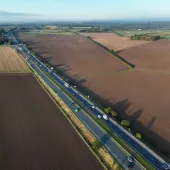Breakthrough for low carbon concrete
The Mineral Products Association (MPA) has announced a major breakthrough today as part of the mission to produce low-carbon concrete.
Containing calcined clays made from reclaimed resources, the MPA said the low-carbon concrete has successfully been used to produce 26 L-shaped retaining wall units at clay and concrete building products manufacturer Forterra's Somercotes site in Derbyshire using calcined clay cements containing as little as 55% Portland cement clinker.
The project, known as Re-C3, was partially funded by UK Resource and Innovation's Transforming Foundation Industries (TFI) Challenge and delivered by Innovate UK, the Engineering and Physical Sciences Research Council (EPSRC) and the Economic and Social Research Council (ESRC), is a partnership between MPA, Forterra, Tarmac (CRH Group), Heidelberg Materials, Imerys, University College London, and University of Dundee to develop a new generation of calcined clays for use in concrete (through inclusion in BS 8500).
Due for completion in March this year, it is believed the results of the project demonstrate that concrete containing calcined clays from across the UK, "at least matches the performance of those produced with GGBS (Ground Granulated Blast-furnace Slag) and fly ash."
The MPA said it expects a more comprehensive report to be released in April after the close of the project.







